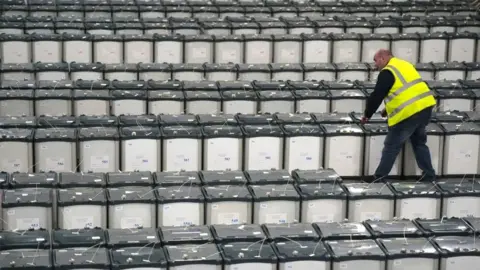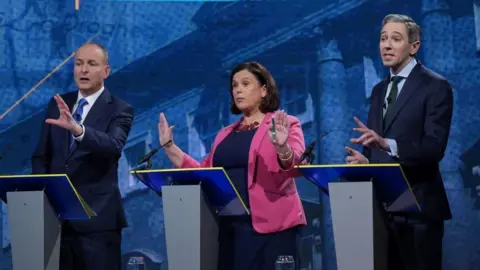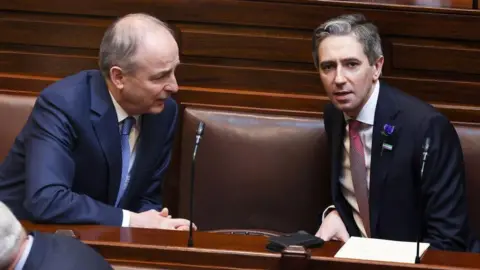How the Republic of Ireland will elect its next parliament
 PA Media
PA MediaThe Irish general election on Friday will decide who will sit in the Dáil, the lower house of the Oireachtas (Ireland's parliament).
Elected members are known as Teachtaí Dála (TDs).
The number of TDs and constituencies will both increase for the 2024 election after a 2023 review.
There are now 43 Dáil constituencies (up from 39 in 2020) which will elect between three and five TDs each.
A total number of 174 TDs will be selected, up from 160 in 2020.
One seat in the Dáil goes to the Speaker, so 88 TDs is the number required for an overall majority.
More than 3.4m people are registered to vote in the Republic of Ireland.
How will votes be counted?
The Republic of Ireland elects its government using a system of proportional representation known as the single transferable vote.
Voters will have the opportunity to rank candidates in their constituency in order of preference, marking their favourite with a number one, a number two beside their next choice and so on.
They can vote for as many or as few candidates as they like.
Candidates will have to reach a certain number of votes in order to be elected.
 PA Media
PA MediaThat number is decided for each constituency using a mathematical formula based on the number of seats available and the number of votes that have been cast.
Counting the ballots takes place in multiple rounds.
Each ballot is initially credited to the first choice.
Once a candidate receives the number of votes required, they are elected and any remaining ballots that are marked with them as first choice are transferred to the second ranked preferences.
Ballots continue to be transferred to the next usable preference until all of the seats in the constituency are filled with candidates who have reached the quota.
What parties are standing in the election?
Politics in the Republic was traditionally dominated by Fianna Fáil and Fine Gael.
Both parties emerged following a split in nationalist opinion over the 1921 Anglo-Irish Treaty.
Fianna Fáil, led by was once seen as more centrist, Fine Gael as more conservative, but differences have blurred and both are now seen as centre-right parties.
Four years ago Fianna Fáil won 38 seats and Fine Gael ended up with 35.
 PA Media
PA MediaTo gain a governing majority, a coalition government was formed between Fianna Fáil, Fine Gael and the Green Party.
This year’s election s the first major electoral test for the Fine Gael leader and outgoing Taoiseach (Irish prime minister) Simon Harris.
Fianna Fáil are led by Michéal Martin, who was taoiseach earlier in the last government term as part of coalition agreement.
Sinn Féin, led by Mary Lou McDonald, is an Irish republican and democratic socialist party and the main opposition party.
In 2020 it made significant gains and topped the popular vote, winning 37 seats.
Since then it has become the largest party across Northern Ireland's councils, as well as in its assembly and at Westminster.
Other parties putting forward candidates for the election include Labour, Social Democrats, PBP-Solidarity, Independent Ireland and Aontú.
What have been the key issues for voters?
Pressures around housing, immigration and public services have dominated the campaign.
Ireland will have a total budget surplus this year of €25bn (£20.8bn), which is made up in part by a huge tax windfall from Apple the parties are making big spending pledges and the parties are making big spending pledges.
But some voters say they “don't see” the country’s healthy bank balance.
The huge cost of renting or buying a home has been a major theme in the campaign while this is the first Irish general election where immigration has been a mainstream issue.
It rose up the agenda following the riots in Dublin in November 2023 however it has not been the defining election topic.
What could a new government look like?
The last poll before the election suggests it’s tight - Fianna Fáil 21%, Fine Gael 20%, Sinn Féin 20%.
The two main parties in the outgoing Irish government have again ruled out Sinn Féin as a potential coalition partner.
Polling also suggests more independent candidates will be elected than in 2020 and if parliamentary arithmetic is tight, their role in government formation could be critical.
 PA Media
PA MediaThe first meeting of the new Dáil is on 18 December but it is unlikely coalition negotiations will have finished by then.
Few expect the new government to be in place before 2025.
A government will be officially formed when the Dáil passes a vote to install a new Taoiseach.
When will votes be counted?
Ballot boxes will be sent to the constituency count centre after polls close on Friday but counting will not start until the following morning.
The count can sometimes last several days.
